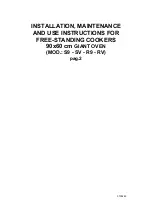
6
9
HOT PLATE
HOT PLATE
Visually double check any installer-supplied intake pipes and/or blow them out using compressed air to
clear any dir t or debris, threading chips, or other foreign matter before installing a service line.
Those par ticles will clog gas ori ces when gas pressure is applied. Compounds used on threaded joints
of this appliance piping must be resistant to the action of NG and LP gas and provide a gas tight seal to
prevent leaks.
The gas pressure regulator must be installed in the gas line failure to install a pressure regulator will void
the equipment warranty. The regulators supplied with ranges have 3/4" NPT connections; the regulator is
adjusted at the factory for 4" W.C. (water column) manifold gas pressure (natural gas) or 10" W.C. manifold
gas pressure for propane gas operation.
Before connecting the regulator, check the incoming line pressure as these regulators can only withstand
a maximum inlet pressure of 14" W.C. (1/2 PSI); exceeding this pressure will damage them. If the gas supply
line pressure is greater than this amount, a step-down regulator will be required.
A gas ow direction arrow is cast into the body of the regulator to minimize installation error it should
point downstream to the appliance.T he blue air vent cap on the top of the regulator is part of the
regulator and should not be removed.
When installing the pressure regulator - remember it can only handle 1/2 PSI. In e very LPG installation, you
have high source pressures, ranging from 20 PSI to 100 PSI. If the high pressure gas line from the LPG tank is
directly connected to the unit without the proper step-down regulator, it will rupture the diaphragm in the
valve, rendering it useless.
!
WARNING
!
WARNING
An
y adjustment to the regulator must be made only by qualified and licensed s e r v i c e personnel
with the proper calibrated test equipment. Gas connections should be performed by a qualified licensed
contractor.
In the event of a power failure, no attempt should be made to operate the unit during power failure.
Like any other piece of equipment, the unit must be cleaned on a regular basis.
CAUTION: FOR YOUR PROTECTION:
This is commerical cooking equipment. If should be kept in
mind that when in operation, the surface temperature will exceed that of equipment designed for
household use. Always maintain the proper clearance as specified in the table cited under General
Information. If the unit is restrained, the operator should be aware of how the unit is restained. The
operator should be familiar with how to connect and disconnect the restraints. If the restraint is
removed for service or maintenance, the restraint must be reconnected prior to putting the unit back
into service.
NEVER
attempt to move or slide the unit when hot.
ALWAYS
let the unit cool down and empty the grease drawer prior to any attempt to relocate or
move the unit.
NEVER
move or transport the unit when the unit is hot.
TO CLEAN THE EXTERIOR
: (Stainless Steel)
1. Let it cool down. Normal daily soil can be removed with a mild detergent or soap solution applied
with a damp cloth. Rinse and dry thoroughly.
2. To remove baked-on grease, apply a cleanser in the directionof the polish lines on the metal.
NEVER rub in a circular motion.
Scotch Brite or Stainless Steel scouring pads may be used on tough or burnt-on deposits that do not
respond to the procedure
above.
6. MAINTENANCE
TO CLEAN THE HOT PLATE INTERIOR:
1. Allow the hot plate interior to cool, completely. Use a nonalkaline based cleaning agent, following
the recommendations of the manufacturer. DO NOT use abrasives.
2. Rinse thoroughly with cool, clean water. Dry thoroughly. Clean daily or as needed.
3. Should the pilot be extinguished, follow the Lighting Instructions.
To reduce down time and for maximum efficiency, have your appliance serviced once or twice a
year, depending on the amount of usage. Have a technician:
Examine the appliance venting system at least twice a year.
Clean and adjust burners, lighters, regulators, and etc. twice a year.
Check and calibrate the thermostats and the manifold pressure at least once a year.
Regrease manual control valves. Call factory for service bulletin.


























